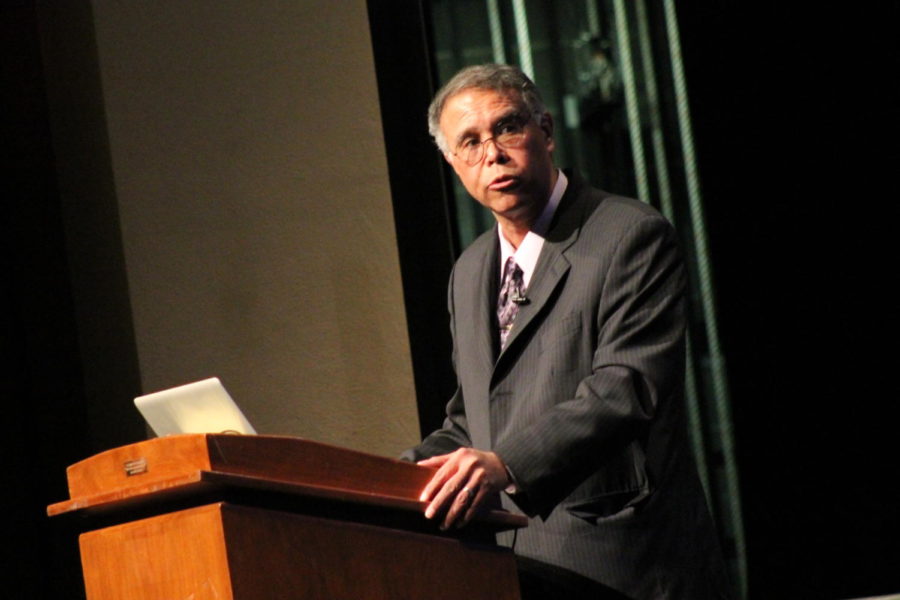Brown: Creationism has no place in science
Richard Martinez / Iowa State Daily
On Sunday, Iowa State University professor of religious studies Hector Avalos and senior pastor at Iglesia Centro Evangelico in Miami, Fla., Rev. Juan Valdes, engaged in a debate in favor of evolution and creationism, respectively, at Indianola High School.
February 20, 2014
For many of us in college, Bill Nye the Science Guy conjures fond memories. Whether they consist of eagerly learning more about science or simply getting to watch a goofy video clip during an otherwise boring class, the level of fame Nye’s work has achieved cannot be doubted.
On Feb. 4, Nye once again grabbed headlines by squaring off in what was touted as a debate with Ken Ham, founder of Kentucky’s Creation Museum and president of Answers in Genesis. Both of these groups advocate for a young-Earth, creationist view of life’s origins, meaning that they sit directly opposed to the overwhelming majority of today’s scientists.
Earlier this week, Hector Avalos, ISU professor in religious studies, was involved in a similar event in Iowa at the Indianola High School. Professor Avalos sparred with the Rev. Juan Valdes, pastor of a Florida congregation. Like Ham, Valdes argues that creationism has a place in modern science, irrespective of the scientific community’s general attitude toward the subject.
Being in this tiny minority does not appear to bother Ham or other scientists who refute evolution and the core principles of essentially all major areas of scientific study. Perhaps this acceptance is because a sizable portion of non-scientists share their views. According to a Pew Research Center poll conducted between March and April, only 60 percent of Americans believe that humans have evolved over time, while 33 percent think we were created in our present form.
Combatting this persistent minority is apparently the reason Nye agreed to attend the so-called debate with Ham in the first place. “I want to show people that this belief is still among us. It finds its way onto school boards in the United States,” said Nye in an interview with the Huffington Post.
With this divide in public opinion, the victor of the highly publicized debate might very well appear different to those with opposing ideals. Few would recognize that, in reality, there was no debate winner because there was no debate. It was called a debate, it looked like a debate and it was moderated like a debate, but it simply wasn’t one.
The question that was to be debated by Nye and Ham, according to moderator Tom Foreman, was “Is creation a viable model of origins in today’s modern scientific era?” In his opening statement, Ham asserts that secularists have hijacked the word “science” and have “arbitrarily” outlawed supernatural explanations for natural events.
This means that Ham is effectively admitting his ideas are not compatible with today’s science, which in turn means that the question that was to be debated was no longer in question. Assuredly, Ham, Valdes and many other creationists disapprove of the way modern scientists rely only on natural explanations and phenomena, but this distinction is fundamentally important to the way we use science.
Since supernatural phenomena, by definition, do not follow the natural laws of the universe, it is impossible for those of us bound in the natural world to fully observe or even understand them in an objective way. On top of this, there is no objective mechanism for choosing between mutually exclusive supernatural explanations.
For example, a well-known ancient Japanese myth claims earthquakes are the result of Namazu, a giant catfish. Usually restrained by the god Kashima, also known as Takemikazuchi, the humongous fish periodically thrashes around violently, causing the earth to quake.
In several Norse myths, the deity Loki is bound in a cave with snake venom dripping above him. His wife collects the venom in a bowl, but must empty it now and then, during which time Loki is burned by the venom. In his agony, Loki contorts in pain, causing earthquakes.
It seems fairly clear that both of these myths are fantasy, but it is certainly clear that they are not both true. According to the logic of Ham or Valdes, though, they are in fact both viable scientific theories, provided a small amount of supporting evidence could be manufactured or cherry picked from modern scientific data.
Religion and science are both part of our lives and our culture. Despite what many on either side of the pseudo-debate would claim, they are not competing theories. On one hand, science is a way to observe and explain the natural world, and on the other religion is a way to explain the supernatural realm and our relationship to it and to each other.
Most religious texts describe natural events in the context of their canon, and many choose to believe these accounts rather than those offered by scientists. This is not in and of itself a bad thing, and those that believe literal interpretations of their sacred text are not simply wrong. They should not, however, mistake their religious beliefs for scientific knowledge. Likewise, proponents of science should not claim certain religious notions are wrong simply because they do not stand up to scientific scrutiny.
Confusing the two not only undermines scientific inquiry and integrity, but opens personal religious convictions to inquiries they do not deserve. Both aspects of our world would be better served remaining distinct and unopposed.

















